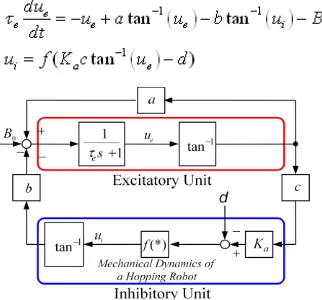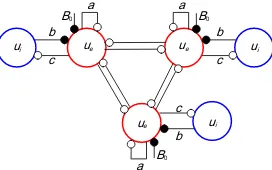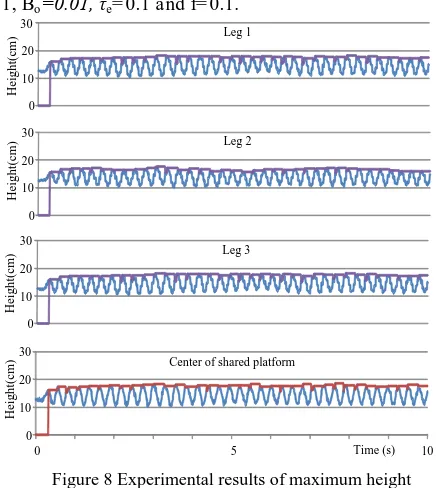Design And Development of Tripod Hopping Robot
A.M.Kassim, N.H .A.Rahim
Universiti Teknikal Malaysia Melaka (UTeM)Hang Tuah Jaya, 76109, Durian Tunggal, Melaka, Malaysia anuar@utem.edu.my
T.Yasuno
The University of Tokushima 2–1 Minamijosanjima–cho Tokushima, 770–8506 JAPAN
yasuno@ee.tokushima-u.ac.jp
Abstract
—
In this paper, we discuss on the validity of using infrared ranging sensor instead of using ultrasonic ranging sensor for the developed tripod hopping robot. The infrared sensor is mounted on the shared platform and the real distance of infrared ranging sensor from the shared platform to the floor in both static and vertical jumping motion are measured. MATLAB&Simulink model including CPG networks is designed to evaluate the performance of infrared ranging sensor by converting the measurement data from infrared ranging sensor from Voltage to Distance by using function blocks. As the result, the jumping height for each hopping motion can be observed. In addition, the maximum height of the developed tripod hopping robot is also evaluated in order to identify the highest jumping capability. Therefore, MATLAB&Simulink model with maximum height detector system is designed without including the PI controller system. As the result, the effectiveness of the maximum height detector system for the developed tripod hopping robot is confirmed in order to evaluate the highest and stable jumping height.Keywords— Tripod hopping robot, CPG networks, maximum height control system
I. INTRODUCTION
Bio-inspired for robot locomotion has been greatly studied by a lot of researchers in the world in these three decades. The types of locomotion that have been studied mostly on legged type, crawling type and flying type locomotion. It is because of the mobility and adaptive motion control that can be achieved by using the bio-inspired method. However, by using this type of locomotion still have a lot of challenges that have to be solved such as complexity of control system, robustness and adaptive motion in various environments and complexity of robot construction. On the other hand, one of the locomotion that also has been focused is jumping type locomotion. Jumping type robot also can be classified in two kind of mechanism which is one big jump and rhythmical jump called hopping type mechanism.
M.H Raibert who has done research on one legged hopping robot is the main contributor of hopping robot research [1]. The first hopping robot invented consists of body and leg which is equipped with a pair of pneumatic actuators to exert torque between the leg and the body about to hip. Then, Koditscheck and Buhler have discovered the discrete dynamic system theory which analyzes the dynamics of a simplified hopping robot which focused on the vertical movement only [2]. Besides, I. Murakami et al. has done his research on hopping robot which control the hopping and moving motion by using the linear DC motor and the gyroscope for attitude
control. The linear DC motor was designed into the body part and the leg part of the hopping robot and constructed the direct-drive hopping mechanism [3].
In addition, Okubo et al. has introduced the design of jumping machine using self-energizing spring. His research has produced a machine or robot which can achieve high jumping performance by using small output actuators [4]. Moreover, Tukagoshi et al. has studied on numerical analysis and design for higher jumping rescue robot by using a pneumatic cylinder. They had developed the leg in rotor type robot which can use in flatted smooth surface (wheeled locomotion) and overcome the irregular surface (jumping locomotion) [5]. Hence, the effectiveness of bio-inspired locomotion of robot also can be implemented by using bio-inspired control system such as neural networks, neural oscillator and etc that consisted non-linear control system as main brain of robot.
On the other hand, physiological experiments suggest that basic locomotors patterns of most living bodies such as walking, flapping, flying and swimming are generated by CPGs which generates rhythmic activities [6]. CPG is neural networks that can endogenously produce rhythmic patterned outputs; these networks underlie the production of most rhythmic motor patterns. The periodic activities of the CPG which are initiated by a burst from the higher motor centre induce the muscle activities. After the initiation of the locomotion, the activities of the CPG are affected by sensory signals which show the bending of the body and so on [7]. The proactive sensory feedback plays an important role in the shaping and coordination of the neural activity with the mechanical activity.
including the motor dynamic characteristics of an actuator for the purpose of implementing generation adaptive gait patterns for a quadruped robot under various environments [12]. Meanwhile, Kondo et al. has developed the quadruped hopping robot which is used central pattern generators (CPGs) as pattern generator in order to generate the continuous jumping performance while control the stability of body balance [13-14].
In this paper, the generation of moving control by using the adaptive CPG including the mechanical dynamic model is proposed for the multi-legged hopping robot. Flexible periodic oscillation can be obtained by applying mechanical dynamics of each leg into the CPG model because the motion feedback loop for the actuator is incorporated into the CPG thus the adaptive hopping motion can be generated in various environments. Besides that, the excitatory neuron of the proposed CPG is mutually connected by the coupling parameters which can adjust the relative phase delay on each leg.
II. DEVELOPEDTRIPOD HOPPING ROBOT
A. Robot Construction
Figure 1 shows the construction of the developed tripod hopping robot which its overall length and width is 26 cm, overall height is 40 cm and its weight is 4.59kg. The tripod hopping robot is consisting of three legs which are connected to a shared platform. A DC geared motor (12V, 200min-1, 0.098Nm), a crank and a spring are joined together to form a leg which is attached to the crankshaft.
Figure 1. Developed tripod hopping robot
DC geared motor plays as the main role of the tripod hopping robot performance. DC amplifier is used to drive the DC geared motor to provide torque through the crank to push the platform.
Figure 2. Hopping mechanism
Figure 2 presents the principle hopping mechanism of the developed tripod hopping robot. Periodical hopping motion of tripod hopping robot is achieved by converting the periodic
force of motor torque to the spring. Floor repulsive force can be used to generate the continuous hopping motion of the tripod hopping robot applying suitable force at suitable time to the spring.
B. Experimental Setup
Figure 3 shows the experimental setup for evaluation of the tripod hopping robot. The system needs two different computers which are connected through ethernet to each other. One of the computers is included with MATLAB&Simulink model functions as the host computer while the other one is functioning as xPC target computer. The model which built by realtime workshop is downloaded to the xPC target computer and run by using realtime OS. The measurement of sensor on each leg will be send to the A/D converter and input to the xPC Target Computer as the experimental results.
-AD16 16(PCI)E
DA12 - 16(PCI) AMP.(JW 143-2) -Ethernet
xP C Target P C1 Target computer
Command signals Simulink
MATLAB & Host computer
Developed tripod hopping robot Output of IR sensor
Figure 3. Experimental Setup
III. SYSTEM CONFIGURATION
A. CPG Model
Figure 4 shows the block diagram of the CPG model which is used for the tripod hopping robot. Mechanical dynamics of the leg is included into the inhibitory unit. Parameters ue and ui
denotes the internal state of the excitatory unit and inhibitory unit, b and c denotes the intrinsic excitatory and inhibitory coupling parameter, a denotes the excitatory coupling factor while Bo denotes the constant bias input. The output of the
inhibitory unit corresponds to the platform position of each leg and is applied to the excitatory unit through a nonlinear function tan-1 (ui) and the feedback gain b which is formulated
as
where f(*) is the mechanical dynamics of the hopping robot’s leg, Ka is the gain constant of the DC amplifier and d is the
external disturbances which is the floor repulsive force for this case. CPG may change the amplitude and frequency of internal states ue and ui by only hanging the coupling parameters a, b, c, continuous hopping performance of the tripod hopping robot is achievable by applying the same periodic force to the spring of the robot.
Figure 5. CPG networks for tripod hopping robot
C. Maximum Height Detection System
Figure 6 shows the block diagram of the maximum height detector system for one leg of developed tripod hopping robot. This block diagram is built by using MATLAB/Simulink tool.
a
Figure 6. Block diagram of maximum height detector system.
This system consists of two main blocks which are memory Function block is explained by the following condition:
a. If the value of A (previous value) is subtracted from the new maximum height will be read out and the system will stop searching until it find the new maximum height.
IV. EXPERIMENTAL RESULT
A. Evaluation on infrared ranging sensor
Firstly, the validation of using infrared ranging sensor instead of ultrasonic sensor on each leg is carried out. This experiment is done because of the limitation of using the ultrasonic ranging sensor since the new developed tripod hopping robot has a limited space to mount the ultrasonic ranging sensor on each leg. Infrared ranging sensor is chosen because of its size which is smaller than the ultrasonic ranging sensor thus a smaller hopping robot can be realized.
There are two conditions while conducting the experiment in order to ensure the validity of using infrared sensor. The first condition is measuring the real distance infrared ranging sensor from the shared platform to the floor when the tripod hopping robotic is not jumping while the second condition measuring the real distance of infrared ranging sensor on the shared platform to the floor when the new developed tripod hopping robot is generating the vertical jumping motion.
Leg 1
Figure 7. Evaluation on infrared ranging sensor
Figure 7 shows the noise existence in measuring data as the first experimental result. Thus, electrical circuit must be modified by mounting a capacitor between the power and ground of infrared ranging sensor as a low pass filter (LPF) into the circuit. As the result, measurement data which is clean from noise can be obtained as shown in figure 8.
B. Evaluation on maximum hopping height system
In addition, experiment of maximum hoping height is also conducted in order to determine the maximum height of the developed tripod hopping robot. Through this experiment, the highest jumping capability of the hopping robot can be determined. The highest jumping value can be used to adjust the reference height of each leg to conduct moving motion experiment. In this experiment, MATLAB/Simulink model which consist of functions blocks to convert the measurement data from infrared sensor which is in Voltage to Distance (cm) is used. The functions blocks are consist of memory block and S-Function block which is already explain in Chapter 3.2 (proposed control system). Reference height of each leg is set in this system just only to check the difference between reference height and maximum height.
The results of maximum height of each leg are shown by figure 9 and figure 10. For this experiment, the internal parameter of CPGs are set to the typical value as a= 0.1, b= 2, c= 1, Bo=0.01, τe= 0.1 and f= 0.1.
Figure 8 Experimental results of maximum height
In order to check the highest jumping height which tripod hopping robot can jump with stability, the effectiveness of the maximum height detector system for the developed hopping robot is determined from the experimental result. Besides that, the maximum height on each jumping performance is also detected. Consequently, the maximum height which can be achieved by the developed tripod hopping robot is 19cm.
V. CONCLUSIONS
In this paper, CPG networks which act as a command centre for the musculoskeletal system and the proposed controller system to generate continuous hopping performances are evaluated. The effectiveness of using infrared ranging sensor instead of ultrasonic ranging sensor for new developed tripod hopping robot is confirmed. By using functions blocks from MATLAB/Simulink, maximum height detector system for the tripod hopping robot is obtained.
In future, we aim to investigate the reference height control system of the tripod hopping robot for better moving motion performance. Besides that, we would like to build simulation model for the tripod hopping robot and by using learning algorithm we aim to acquire the CPGs parameters and coupling parameters of CPG networks for hopping at arbitrary place.
ACKNOWLEDGMENT
This research was supported by grant from Universiti Teknikal Malaysia Melaka award no. PJP/2011/FKE (32C) S948 and also technicially support from Yasuno laboratory member, The University of Tokushima, Japan.
REFERENCES
[1] M.H Raibert; Legged Robot That Balance, MIT Press, Cambridge,
Massachusetts, 1986
[2] D. E. Koditscheck and M. Buhler: Analysis of a simplified hopping
robot, Int. Journal of Robotics Res., Vol.10(6), pp. 587–605, 1991.
H. Kojima, I. Murakami, S. Yoshida, T. Sekiya: Development of Linear DC Motor surrounded by Four Faces for Hopping Robot and Experiments of Continuous Hopping, J. Robotics Soc. Japan, Vol.14(1),
pp.91–95, 1994.(In Japanese)
[3] H. Okubo, E. Nakano: General Knowledgement on Jumping type robot,
J. Robotics Soc. Japan, Vol.11(3), pp. 342–347, 1998.(In Japanese)
[4] H. Tsukagoshi, M. Sasaki, A. Kitagawa, T. Tanaka: Numerical Analysis
and Design for Higher Jumping on Debris Using a Pneumatic Cylinder,
Journal of The Society of Instrument and Control, Vol.40(8), pp. 859–
866, 2004.(In Japanese)
[5] Grillner S,Neurobiological Bases of Rhythmic Motor Acts Invertebrates,
Science, Vol.228, pp.143-149, 1985.
[6] William TL, Sigvardt KA, Kopell N, Ermentrout GB, Remler MP;
Forcing of Coupled Nonlinear Oscillator: Studies of Intersegmental Coordination in the Lamprey Locomotor Central Pattern Generator, Journal of Neurophysiol, No.64(3), pp 862-871, 1990.
[7] Bassler U; On the Definition of the Central Pattern Generator and its
Sensory Control, Biol. Cybernatics, No.54, pp 65-69, 1986.
[8] Marder E and Calabrese RL: Principles of rhythmic motor pattern
production, Physiological Reviews, No. 76, pp 687–717, 1996.
[9] G. Taga: A model of the neuro-musculo-skeletel system for human
locomotion emergence of basic gait, Biol. Cybernetics, No.73,pp. 97–
111, 1995.
[10] G. Taga: A model of the neuro-musculo-skeletel system for human
locomotion realtime adaptability under various constraints, Biol.
Cybernetics, No.73, pp. 113–121, 1995.
[11] H. Kimura: Dynamic walking on irregular terrain and running on flat
terrain of the quadruped using neural oscillator, J. Robotics Soc. Jpn.,
Vol.16, No.8, pp. 1138–1145, 1998.
[12] Y. Son, T. Kamano, T. Yasuno, T. Suzuki, and H. Harada: Generation of
adaptive gait patterns for quadruped robot Using CPG Network,
Electrical Eng. Jpn., Vol.115, No.1, pp. 35–43, 2006.
[13] K. Kondo, T. Yasuno and H. Harada: Generaton of jumping motion
patterns for quadruped hopping robot using CPG network, Journal of
Signal Processing, Vol.11,No.11,pp. 321–324, 2007.


